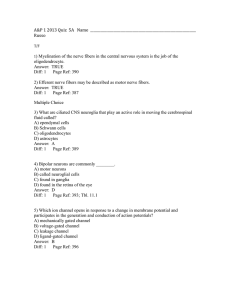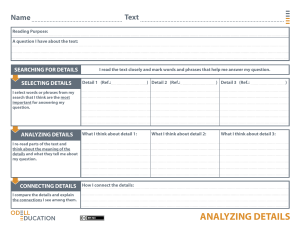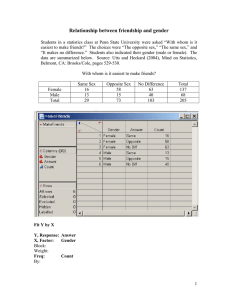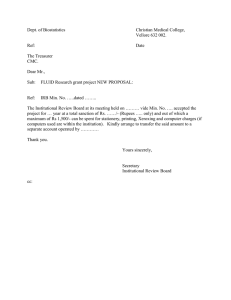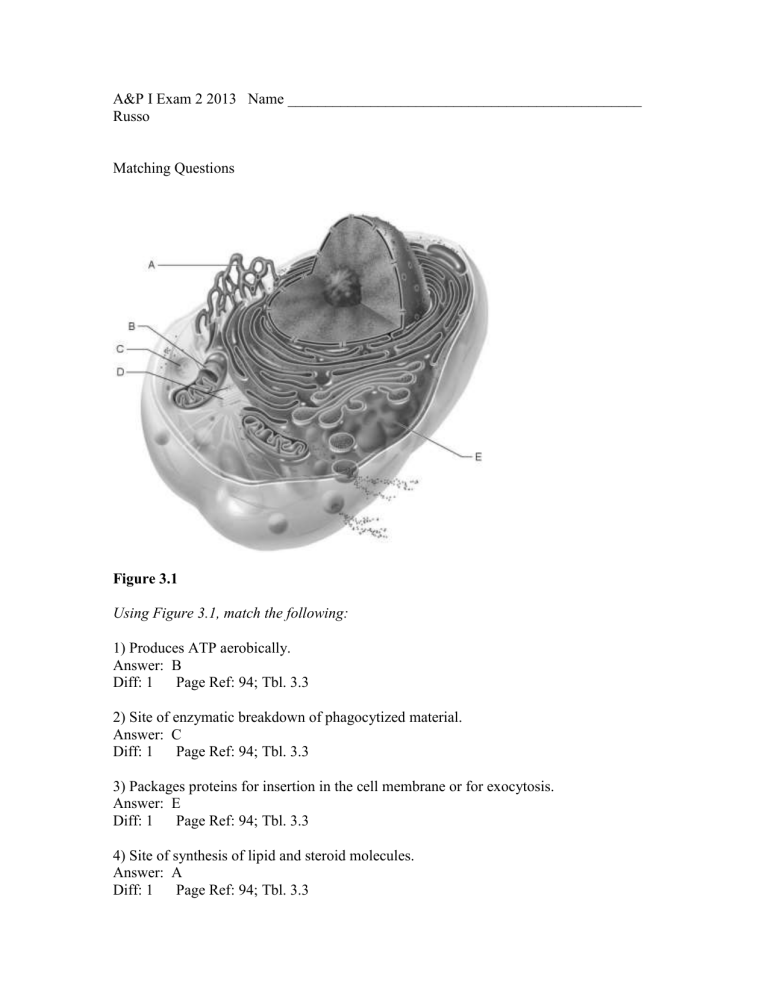
A&P I Exam 2 2013 Name _______________________________________________ Russo Matching Questions Figure 3.1 Using Figure 3.1, match the following: 1) Produces ATP aerobically. Answer: B Diff: 1 Page Ref: 94; Tbl. 3.3 2) Site of enzymatic breakdown of phagocytized material. Answer: C Diff: 1 Page Ref: 94; Tbl. 3.3 3) Packages proteins for insertion in the cell membrane or for exocytosis. Answer: E Diff: 1 Page Ref: 94; Tbl. 3.3 4) Site of synthesis of lipid and steroid molecules. Answer: A Diff: 1 Page Ref: 94; Tbl. 3.3 5) Forms the mitotic spindle. Answer: D Diff: 1 Page Ref: 94; Tbl. 3.3 6) Replicate for cell division. Answer: D Diff: 1 Page Ref: 94; Tbl. 3.3 7) Source of cell autolysis. Answer: C Diff: 2 Page Ref: 94; Tbl. 3.3 Match the following: A) Transfer RNA B) Synthetase enzymes C) Ribosomal RNA D) ATP E) Messenger RNA 8) Forms part of the protein synthesis site in the cytoplasm. Diff: 1 Page Ref: 102 9) Act as "interpreter" molecules that recognize specific amino acids and nucleotide base sequences. Diff: 1 Page Ref: 102 10) Attaches the correct amino acid to its transfer RNA. Diff: 1 Page Ref: 104 11) Provides the energy needed for synthesis reactions. Diff: 1 Page Ref: 104 12) Produced in the nucleus, this molecule specifies the exact sequence of amino acids of the protein to be made. Diff: 1 Page Ref: 102 13) May be attached to the ER or scattered in the cytoplasm. Diff: 1 Page Ref: 102 Answers: 8) C 9) A 10) B 11) D 12) E 13) C T/F 14) Each daughter cell resulting from mitotic cell division has exactly as many chromosomes as the parent cell. Answer: TRUE Diff: 1 Page Ref: 98 15) Apoptosis is programmed cell suicide; cancer cells do not undergo this process. Answer: TRUE Diff: 1 Page Ref: 110 16) Introns represent a genome scrap yard that provides DNA segments for genome evolution and a variety of small RNA molecules. Answer: TRUE Diff: 2 Page Ref: 102 17) Final preparation for cell division is made during the cell life cycle subphase called G2. Answer: TRUE Diff: 2 Page Ref: 97 18) Lipid rafts, found in the cell outer membrane surface, are concentrating platforms for certain receptor molecules or for protein molecules needed for cell signaling.. Answer: TRUE Diff: 3 Page Ref: 65 19) Which vesicular transport process occurs primarily in some white blood cells and macrophages? A) exocytosis B) phagocytosis C) pinocytosis D) intracellular vesicular trafficking Answer: B Diff: 3 Page Ref: 78; Tbl. 3.2 20) The RNA responsible for bringing the amino acids to the ribosome for protein formation is ________. A) rRNA B) mRNA C) tRNA D) ssRNA Answer: C Diff: 1 Page Ref: 102 21) A red blood cell placed in pure water would ________. A) shrink B) swell initially, then shrink as equilibrium is reached C) neither shrink nor swell D) swell and burst Answer: D Diff: 1 Page Ref: 71; Fig. 3.9 22) Which of the following describes the plasma membrane? A) a single-layered membrane that surrounds the nucleus of the cell B) a double layer of protein enclosing the plasma C) a phospholipid bilayer surrounding the cell D) a membrane composed of tiny shelves or cristae Answer: C Diff: 1 Page Ref: 63-64 23) Which of these is not a function of the plasma membrane? A) It is selectively permeable but permits water and gases to cross. B) It prevents potassium ions from leaking out and sodium ions from crossing into the cell. C) It acts as a site of cell-to-cell interaction and recognition. D) It encloses the cell contents in such a way that water I the body is divided into separate compartments. Answer: B Diff: 1 Page Ref: 68 24) Which structures are fingerlike projections that greatly increase the absorbing surface of cells? A) stereocilia B) microvilli C) primary cilia D) flagella Answer: B Diff: 1 Page Ref: 90 25) Which of the following statements is correct regarding net diffusion? A) The rate is independent of temperature. B) The greater the concentration gradient, the faster the rate. C) Molecular weight of a substance does not affect the rate. D) The lower the temperature, the faster the rate. Answer: B Diff: 2 Page Ref: 68 Match the following: A) Endothelium B) Mucous membrane C) Serous membrane D) Cutaneous 26) The epithelial membrane that lines the closed ventral cavities of the body. Diff: 1 Page Ref: 142; Fig. 4.11 27) The epithelial membrane that lines body cavities open to the exterior membrane Diff: 1 Page Ref: 141; Fig. 4.11 28) Consists of keratinized stratified squamous epithelium. Diff: 2 Page Ref: 140 29) Found lining the digestive and respiratory tracts. Diff: 2 Page Ref: 141; Fig. 4.11 30) Makes up the pleura and pericardium. Diff: 2 Page Ref: 142; Fig. 4.11 31) Lines blood vessels and the heart. Diff: 1 Page Ref: 120 Answers: 26) C 27) B 28) D 29) B 30) C 31) A Match the following: A) Cardiac muscle B) Tendon C) Smooth muscle D) Skin epidermis 32) Derived from mesenchyme Diff: 1 Page Ref: 129; Fig. 4.8d 33) Has a surface to which nothing is attached Diff: 1 Page Ref: 121 34) Moves blood through the body Diff: 1 Page Ref: 138 35) Moves food through the GI tract Diff: 1 Page Ref: 138 Answers: 32) B 33) D 34) A 35) C Multiple Choice 36) Which of the following is not found in the matrix of cartilage but is found in bone? A) living cells B) lacunae C) blood vessels D) organic fibers Answer: C Diff: 2 Page Ref: 136 37) The reason that intervertebral discs exhibit a large amount of tensile strength, which allows them to absorb shock, is because they possess ________. A) hydroxyapatite crystals B) collagen fibers C) reticular fibers D) elastic fibers Answer: B Diff: 2 Page Ref: 134 38) What tissue has lacunae, calcium salts, and blood vessels? A) cartilage tissue B) fibrocartilaginous tissue C) osseous tissue D) areolar tissue Answer: C Diff: 2 Page Ref: 136 39) How is hyaline cartilage different from elastic or fibrocartilage? A) It is more vascularized. B) It contains more nuclei. C) Fibers are not normally visible. D) It forms most of the embryonic skeleton.. Answer: C Diff: 1 Page Ref: 134 40) The blast cell for blood production is the ________. A) osteoblast B) chondroblast C) hemocytoblast D) fibroblast Answer: C Diff: 2 Page Ref: 128 41) Which of the following would be of most importance to goblet cells and other glandular epithelium? A) microvilli B) Golgi bodies C) lysosomes D) multiple nuclei Answer: B Diff: 3 Page Ref: 124; Fig. 4.4 42) The simple columnar epithelium that form absorptive cells of the digestive tract have which characteristic? A) dense microvilli B) a rich vascular supply C) fibroblasts D) cilia Answer: A Diff: 1 Page Ref: 120 43) Pseudostratified columnar epithelium ciliated variety ________. A) lines most of the respiratory tract B) aids in digestion C) possesses no goblet cells D) is not an epithelial classification Answer: A Diff: 2 Page Ref: 120-122 44) Which of the following is a single-celled layer of epithelium that forms the lining of serous membranes? A) pseudostratified columnar B) simple columnar C) simple squamous D) simple cuboidal Answer: C Diff: 1 Page Ref: 120-122 45) Connective tissue matrix is composed of ________. A) cells and fibers B) fibers and ground substance C) ground substance and cells D) all organic compounds Answer: B Diff: 1 Page Ref: 127 T/F 46) Short, irregular, and flat bones have marrow cavities in order to keep the weight of the bones light. Answer: FALSE Diff: 1 Page Ref: 177 47) In newborn infants, the medullary cavity and all areas of spongy bone contain yellow bone marrow. Answer: FALSE Diff: 1 Page Ref: 193-194 48) The structural unit of compact bone (osteon) resembles the growth rings of a tree trunk. Answer: TRUE Diff: 1 Page Ref: 181 49) The term osteoid refers to the organic part of the matrix of compact bones. Answer: TRUE Diff: 1 Page Ref: 183 50) Sixty-five percent of the mass of bone is a compound called hydroxyapatite. Answer: TRUE Diff: 1 Page Ref: 183 51) All bones stop growing by the end of adolescence. Answer: FALSE Diff: 2 Page Ref: 185-186 Multiple Choice 52) The structure of bone tissue suits the function. Which of the following bone tissues is adapted to support weight and withstand tension stress? A) spongy bone B) irregular bone C) compact bone D) trabecular bone Answer: C Diff: 1 Page Ref: 177-179 53) Yellow bone marrow contains a large percentage of ________. A) fat B) blood-forming cells C) elastic tissue D) Sharpey's fibers Answer: A Diff: 1 Page Ref: 178 54) The cell responsible for secreting the matrix of bone is the ________. A) osteocyte B) osteoblast C) osteoclast D) chondrocyte Answer: B Diff: 1 Page Ref: 179; Fig. 6.5 55) What kind of tissue is the forerunner of long bones in the embryo? A) elastic connective tissue B) dense fibrous connective tissue C) fibrocartilage D) hyaline cartilage Answer: D Diff: 1 Page Ref: 183-184 56) What can a deficiency of growth hormone during bone formation cause? A) inadequate calcification of bone B) decreased osteoclast activity C) decreased proliferation of the epiphyseal plate cartilage D) increased osteoclast activity Answer: C Diff: 1 Page Ref: 186-187 57) A fracture in the shaft of a bone would be a break in the ________. A) epiphysis B) metaphysis C) diaphysis D) articular cartilage Answer: C Diff: 1 Page Ref: 177 58) The term diploë refers to the ________. A) double-layered nature of the connective tissue covering the bone B) fact that most bones are formed of two types of bone tissue C) internal layer of spongy bone in flat bones D) two types of marrow found within most bones Answer: C Diff: 1 Page Ref: 177 59) Which of the following is a bone marking name that indicates an armlike bar of bone? A) meatus B) ramus C) foramen D) fossa E) epicondyle Answer: B Diff: 1 Page Ref: 180; Tbl. 6.1 60) What causes osteoporosis? A) poor posture B) Osteoclasts out-pace osteoblasts due to low hormone production of the ovaries. C) heritage such as African or Mediterranean D) abnormal PTH receptors Answer: B Diff: 2 Page Ref: 192-193 Xtra Credit 1) Which of the following would be of most importance to goblet cells and other glandular epithelium? A) microvilli B) Golgi bodies C) lysosomes D) multiple nuclei Answer: B Diff: 3 Page Ref: 124; Fig. 4.4 2) Select the correct statement regarding epithelia. A) Simple epithelia form impermeable barriers. B) Stratified epithelia are tall, narrow cells. C) Stratified epithelia are present where protection from abrasion is important. D) Pseudostratified epithelia consist of at least two layers of cells stacked on top of one another. Answer: C Diff: 2 Page Ref: 119 3) Normal bone formation and growth are dependent on the adequate intake of ________. A) calcium, phosphate, and vitamin D B) potassium, phosphate, and vitamin D C) sodium, calcium, and vitamin E D) vitamin D, phosphate, and chloride Answer: A Diff: 3 Page Ref: 187 4) Which of the following statements best describes interstitial growth? A) Growth occurs in the lining of the long bones. B) Fibroblasts give rise to chondrocytes that differentiate and form cartilage. C) Unspecialized cells from mesenchyme develop into chondrocytes, which divide and form cartilage. D) Chondrocytes in the lacunae divide and secrete matrix, allowing the cartilage to grow from within. Answer: D Diff: 2 Page Ref: 174 5) Which of the following is the single most important stimulus for epiphyseal plate activity during infancy and childhood? A) parathyroid hormone B) calcium C) growth hormone D) thyroid hormone Answer: C Diff: 2 Page Ref: 186
